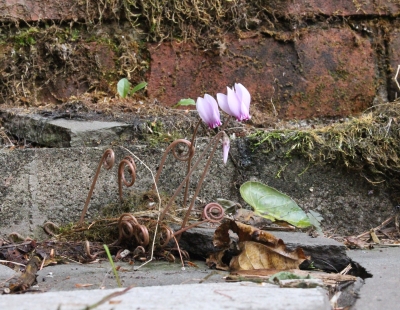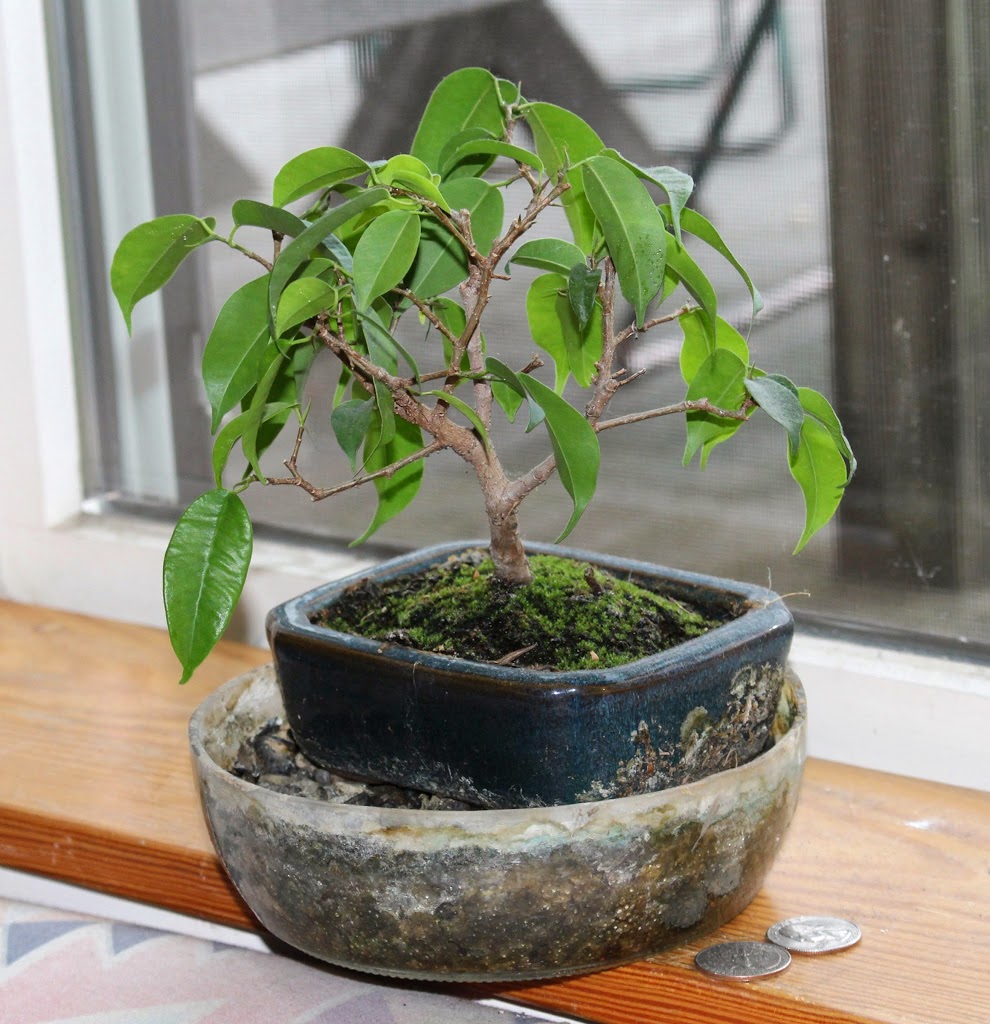LOOK BEYOND POINSETTIA GLITZ
A Harem of Males
Phew, what a year 2020 was! Well, it’s over and, at least at this writing, things look hopeful for the future, at least from my perspective. Except if you live in a tropical or subtropical climate, there’s not much distraction from anything gardenwise, for now, so let’s take a close look at a plant no doubt sitting on many coffee tables and windowsills. Poinsettia. I’m not a big fan of their appearance, but I do like them as botanical curiosities.
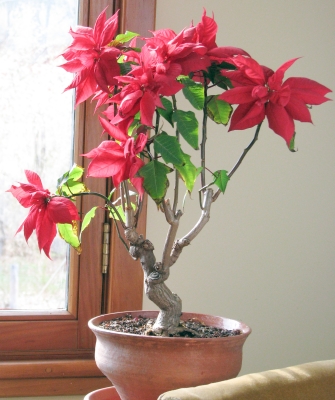
Let’s share some botanical lore of this plant by setting your holiday poinsettia on a table in good light for a close look at its flowers. I say “close ” because the flowers are not those large, red, leaf-like structures. The large, red, leaf-like structures are just that — leaves, albeit modified leaves called bracts. The bracts attract pollinating insects to the plant.
The actual flowers of the poinsettia, which are not very showy at all, originate within the small, greenish, cup-shaped structures you see above the bracts. These cup-shaped structures are “cyathiums.”
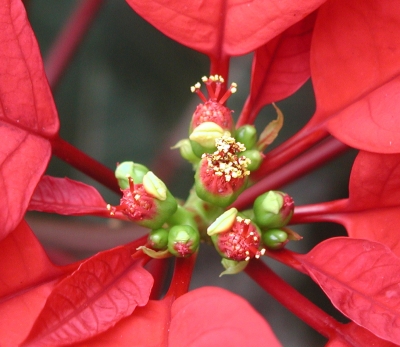
Each cyathium contains a single female flower surrounded by a harem of males. Pluck a cyathium from the plant, take a sharp knife or razor, and slice it in half from top to bottom. A magnifying glass helps now. You’ll see that the inner wall of the cyathium is lined with numerous tiny flowers which, when the flower is mature, protrude up through the opening of the cup. These are all male flowers.
Look very carefully and you’ll also see a stalk attached to the very bottom of the cyathium, protruding up through the cup opening, and capped by what looks like a turban. That is the single, female flower, which, to promote cross- rather than self-pollination, emerges from the cyathium after male flowers begin to shrivel. Cross-pollination promotes genetic diversity for healthier plants.
In addition to the male and female flowers, on the outside of the cyanthium is a single yellow gland that looks like the mouth of a fish poised to ingest food.
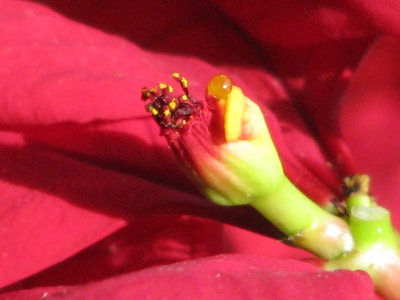
Next time a friend comments on the beauty of your poinsettia flower, take out a magnifying glass and closely examine a few cyathiums before looking up and agreeing nonchalantly.
Fool the Plant
Have you ever wondered how stores always manage to have blooming poinsettias for the holiday season?
Poinsettia, along with chrysanthemums and most strawberry varieties, is a “short-day” plant. Short-days induce “short-day” plants to form flower buds. (In reality, plants are responding to long nights, but the phenomenon was originally thought to be daylength dependent, and the term “short-day” plants has stuck with us.) Poinsettia can be fooled into blooming at any time of the year merely by exposing it to artificially shortened days.
To secure blooming plants for this past holiday season, poinsettias grown in large commercial greenhouse ranges were covered with a shade cloth so that they experienced 14 hours of darkness each “night” beginning around September. After 8 weeks of this treatment, they formed flower buds which became fully developed just before the holiday season.
You Do It
You can do this at home to make this year’s poinsettias bloom again whenever you want. Your poinsettias first will need a rest period. Loss of leaves and fading flowers indicate that your plants are entering dormancy. (Even tropical plants, such as poinsettia, do take a short, mild annual rest.) When the plants become dormant, move them to where it is cool. Water them infrequently, just enough to keep their stems from shriveling.
About April, the plants will be ready to start growing again. Cut the stems back to a few strong shoots, each about 6 inches long. Give the plants sun, warmth, and water. New shoots will push forth from dormant buds. When warm weather has settled, you can put the plants outside.
As temperatures cool in late summer, bring the plants indoors to a sunny window. Keep them away from cold drafts, which would cause their leaves to drop.
Now for the photoperiod treatment. Beginning three months before you would like the plants to bloom, make sure the plants get 14 hours of darkness each night. Moving them into a dark closet or covering them with a paper bag are convenient ways to do this.
The dark period each night must be uninterrupted. Even peek at them with a flashlight at midnight will have them acting as if they had a short night, instead of the needed long night.
After 8 weeks of the above treatment, move the plants back to their sunny window. Flower buds should be evident, and you should have blooming poinsettias within a month. If you want bloom for the holiday season next year, start the photoperiod treatment about the middle of September.
Poisonous?
Poinsettia, Euphorbia pulcherrima, is a member of the Euphorbiaceae family, commonly called the Spurge family. A common characteristic of plants in this family — which includes Hevea braziliensis, tapped commercially to make rubber — is the milky sap they exude when cut. The sap has often been considered poisonous and was sometimes used medicinally as a purge (hence “spurge,” from the French word espugier, meaning to purge). But, as Philippus Aureolus Theophrastus Bombastus von Hohenheim, more commonly known as Paracelsus, wrote in the 15th century, “All things are poisons, for there is nothing without poisonous qualities. It is only the dose which makes a thing poison.”
In fact, the sap is only mildly poisonous to humans and other animals. It can cause a rash on the skin or mouth, and stomach upset. So go ahead and nick the stem of your poinsettia and see the milky sap exude. No need to touch it.

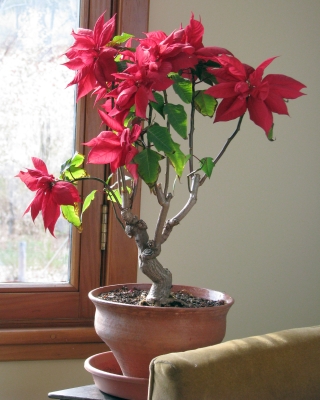 Breeding, manipulation of their greenhouse environment, and plant growth regulators have transformed this sporadically blooming native of Mexico into a compact plant bursting into large blossoms for Christmas in foil wrapped pots.
Breeding, manipulation of their greenhouse environment, and plant growth regulators have transformed this sporadically blooming native of Mexico into a compact plant bursting into large blossoms for Christmas in foil wrapped pots.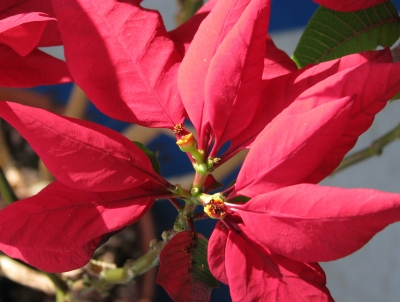
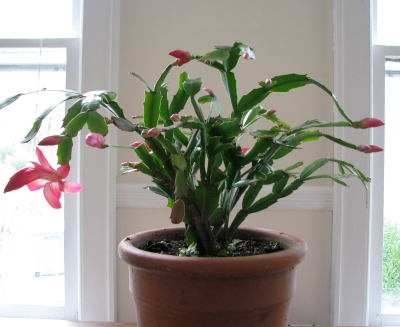 Above 60°F, temperature steps in to play a role. At room temperatures, or thereabouts, a Christmas cactus needs about the same day length as does poinsettia, except that it might not need the weeks and weeks of short days before it decides to bloom. Then again, it might wait a few weeks, to throw in another wrinkle, depending on the variety of Christmas cactus.
Above 60°F, temperature steps in to play a role. At room temperatures, or thereabouts, a Christmas cactus needs about the same day length as does poinsettia, except that it might not need the weeks and weeks of short days before it decides to bloom. Then again, it might wait a few weeks, to throw in another wrinkle, depending on the variety of Christmas cactus. This time of year, late fall going into winter, is when the plant is flowering and wants to be kept cool (preferably no higher than about 65°F.), moist (but not waterlogged), and in indirect light (which casts no more than a fuzzy shadow). Under these conditions, those butterflies can hover over the plant for weeks and weeks.
This time of year, late fall going into winter, is when the plant is flowering and wants to be kept cool (preferably no higher than about 65°F.), moist (but not waterlogged), and in indirect light (which casts no more than a fuzzy shadow). Under these conditions, those butterflies can hover over the plant for weeks and weeks.
